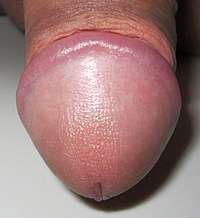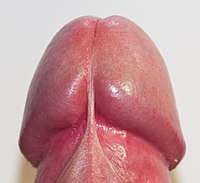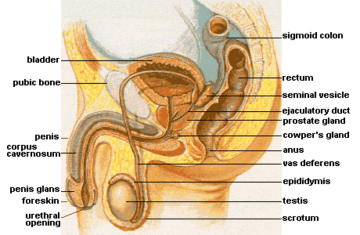Glans penis
The glans penis, more commonly referred to as the glans, is a structure at the distal end of the penis in male mammals. It is the sensitive bulbous structure at the end of the human penis, and is anatomically homologous to the clitoral glans of the human female. The glans penis may be smooth, spiny, elongated, or divided in other mammals.
| Glans penis | |
|---|---|
 Glans penis (dorsal view) | |
 Glans penis (ventral view) | |
| Details | |
| Synonyms | Glans |
| Pronunciation | /ɡlænz/[1] |
| Artery | Urethral artery |
| Identifiers | |
| Latin | Glans penis |
| TA | A09.4.01.007 |
| FMA | 18247 |
| Anatomical terminology | |

Typically, the glans is completely or partially covered by the foreskin in humans, except in those who have been circumcised. The foreskin can generally be retracted over and past the glans, and may automatically retract during an erection. The glans is more commonly known as the "head" or the "tip" of the penis. The medical name comes from the Latin words glans ('acorn') and penis ('of the penis') – the Latin genitive of this word has the same form as the nominative.
In humans
Structure
The glans penis is the expanded cap of the corpus spongiosum. It is moulded on the rounded ends of the corpora cavernosa penis, extending farther on their upper than on their lower surfaces. At the summit of the glans is the slit-like vertical external urethral orifice. The circumference of the base of the glans forms a rounded projecting border, the corona glandis, overhanging a deep retroglandular sulcus (the coronal sulcus), behind which is the neck of the penis. The proportional size of the glans penis can vary greatly. On some penises it is much wider in circumference than the shaft, giving the penis a mushroom-like appearance, and on others it is narrower and more akin to a probe in shape. The soft cushiony texture of the glans is intended to absorb impact during rigorous instances of copulation.[2]
The foreskin maintains the mucosa in a moist environment.[3] Circumcised penises have a glans which is permanently exposed and dry. Several studies have suggested the glans is equally sensitive in both circumcised and uncircumcised penises,[4][5][6] while others have reported it is more sensitive in people who are not circumcised.[7][8]
Halata & Munger (1986) report that the density of genital corpuscles is greatest in the corona glandis,[9] while Yang & Bradley's (1998) report "showed no areas in the glans to be more densely innervated than others."[10]
Halata & Spathe (1997) reported; "the glans penis contains a predominance of free nerve endings, numerous genital end bulbs and rarely Pacinian and Ruffinian corpuscles. Merkel nerve endings and Meissner's corpuscles are not present."[11]
Yang & Bradley argue; "the distinct pattern of innervation of the glans emphasizes the role of the glans as a sensory structure".[10] Some researchers have suggested that the glans has evolved to become acorn, mushroom or cone shaped so that during copulation it acts as a semen-removal device in the vagina of previous sex partners, but this is not supported when looking at primate relatives who have different mating behaviors.[12][13]
Clinical significance
The meatus (opening) of the urethra is located at the tip of the glans penis.
The epithelium of the glans penis is mucocutaneous tissue.[11] Birley et al. report that excessive washing with soap may dry the mucous membrane which covers the glans penis and cause non-specific dermatitis.[14]
Inflammation of the glans penis is known as balanitis, and, occurs in 3–11% of males (up to 35% of diabetic males). Edwards reported that it is generally more common in males who have poor hygiene habits or have not been circumcised.[15] It has many causes, including irritation, or infection with a wide variety of pathogens. Careful identification of the cause with the aid of patient history, physical examination, swabs and cultures, and biopsy are essential in order to determine the proper treatment.[15]
Meatal stenosis is a late complication of circumcision, which occurs in about 2 to 20 percent of circumcised boys.[16][17]
Other animals
Male felids are able to urinate backwards by curving the tip of the glans penis backward.[18][19] In cats, the glans penis is covered with spines, but in dogs, the glans is smooth. Penile spines also occur on the glans of male and female spotted hyenas.[18]
In male dogs, the glans penis consists of two parts called the bulbus glandis and pars longa glandis.[20] The glans of a fossa's penis extends about halfway down the shaft and is spiny except at the tip. In comparison, the glans of felids is short and spiny, while that of viverrids is smooth and long.[21] The shape of the glans varies among different marsupial species.[22][23][24] In most marsupials, the glans is divided, but male macropods have an undivided glans penis.[25] The glans penis is also divided into two parts in platypuses and echidnas.[26][27]
The glans penis of the marsh rice rat is long and robust,[28] averaging 7.3 mm (0.29 in) long and 4.6 mm (0.18 in) broad.[29]
In Thomasomys ucucha the glans penis is rounded, short, and small and is superficially divided into left and right halves by a trough at the top and a ridge at the bottom. Most of the glans is covered with spines, except for an area near the tip.[30]
Winkelmann's mouse can most readily be distinguished from its close relatives by its partially corrugated glans penis.[31]
When erect, the glans of a horse's penis increases by 3 to 4 times. The urethra opens within the urethral fossa, a small pouch at the distal end of the glans.[32] Unlike the human glans, the glans of a horse's penis extends backwards on its shaft.[33][34][35][36][37][38][39][40][41]
Males of Racey's pipistrelle bat have a narrow, egg-shaped glans penis.[42]
The glans penis of a male cape ground squirrel is large with a prominent baculum.[43]
See also
- Clitoris
- Corona of glans penis
- Corpus cavernosum penis
- Foreskin
- Frenulum of prepuce of penis
- Hirsuties papillaris genitalis
References
- OED 2nd edition, 1989.
- HSU, G‐L., et al. "The distribution of elastic fibrous elements within the human penis." BJU International 73.5 (1994): 566-571.
- Prakash, Satya; Raghuram Rao; K. Venkatesan; S. Ramakrishnan (July 1982). "Sub-Preputial Wetness--Its Nature". Annals of National Medical Science (India). 18 (3): 109–112.
- Bleustein, Clifford B.; James D. Fogarty; Haftan Eckholdt; Joseph C. Arezzo; Arnold Melman (April 2005). "Effect of neonatal circumcision on penile neurologic sensation". Urology. 65 (4): 773–7. doi:10.1016/j.urology.2004.11.007. PMID 15833526.
- Bleustein, Clifford B.; Haftan Eckholdt; Joseph C. Arezzo; Arnold Melman (April 26 – May 1, 2003). "Effects of Circumcision on Male Penile Sensitivity". American Urological Association 98th Annual Meeting. Chicago, Illinois. Archived from the original on February 7, 2005.
- Payne, Kimberley; Thaler, Lea; Kukkonen, Tuuli; Carrier, Serge; Binik, Yitzchak (May 2007). "Sensation and Sexual Arousal in Circumcised and Uncircumcised Men". Journal of Sexual Medicine. 4 (3): 667–674. doi:10.1111/j.1743-6109.2007.00471.x. PMID 17419812.
- Sorrells, Morris L.; Snyder, James L.; Reiss, Mark D.; Eden, Christopher; Milos, Marilyn F.; Wilcox, Norma; Van Howe, Robert S. (April 2007). "Fine-touch pressure thresholds in the adult penis". British Journal of Urology International. 99 (4): 864–869. doi:10.1111/j.1464-410X.2006.06685.x. PMID 17378847.
- Yang, DM; Lin H; Zhang B; Guo W (April 2008). "Circumcision affects glans penis vibration perception threshold". Zhonghua Nan Ke Xue. 14 (4): 328–330. PMID 18481425.
- Halata, Zdenek; Bryce L. Munger (April 1986). "The neuroanatomical basis for the protopathic sensibility of the human glans penis". Brain Research. 371 (2): 205–30. doi:10.1016/0006-8993(86)90357-4. PMID 3697758.
- Yang, C. C.; W.E. Bradley (July 1998). "Neuroanatomy of the penile portion of the human dorsal nerve of the penis". British Journal of Urology. 82 (1): 109–13. doi:10.1046/j.1464-410x.1998.00669.x. PMID 9698671.
- Halata, Zdenek; A. Spaethe (1997). Sensory innervation of the human penis. Advances in Experimental Medicine and Biology. 424. pp. 265–6. doi:10.1007/978-1-4615-5913-9_48. ISBN 978-0-306-45696-1. PMID 9361804. Retrieved 2006-07-07.
- Gallup, Gordon G., et al. "The human penis as a semen displacement device." Evolution and Human Behavior 24.4 (2003): 277-289
- Dixson, Alan F. (2009). Sexual Selection and the Origins of Human Mating Systems. OUP Oxford. p. 68. ISBN 9780191569739.
- Birley, H. D.; M .M. Walker; G. A. Luzzi; R. Bell; D. Taylor-Robinson; M. Byrne; A. M. Renton (October 1993). "Clinical features and management of recurrent balanitis; association with atopy and genital washing". Genitourinary Medicine. 69 (5): 400–3. doi:10.1136/sti.69.5.400. PMC 1195128. PMID 8244363.
- Edwards, Sarah (June 1996). "Balanitis and balanoposthitis: a review". Genitourinary Medicine. 72 (3): 155–9. doi:10.1136/sti.72.3.155. PMC 1195642. PMID 8707315.
- Sorokan SK, Finlay JC, Jefferies AL. Canadian Paediatric Society. Newborn male circumcision; 2015 [Retrieved 20 October 2017].
- Koenig JF. EMedicine. Meatal stenosis; 22 September 2016 [Retrieved 2 October 2017].
- R. F. Ewer (1973). The Carnivores. Cornell University Press. pp. 116–. ISBN 978-0-8014-8493-3. Retrieved 8 February 2013.
- Reena Mathur (2010). Animal Behaviour 3/e. Rastogi Publications. ISBN 978-81-7133-747-7. Retrieved 10 February 2013.
- Howard E. Evans; Alexander de Lahunta (7 August 2013). Miller's Anatomy of the Dog. Elsevier Health Sciences. ISBN 978-0-323-26623-9.
- Köhncke, M.; Leonhardt, K. (1986). "Cryptoprocta ferox" (PDF). Mammalian Species (254): 1–5. Retrieved 19 May 2010.
- Australian Mammal Society (December 1978). Australian Mammal Society. Australian Mammal Society. pp. 73–. Retrieved 25 December 2012.
- Wilfred Hudson Osgood; Charles Judson Herrick (1921). A monographic study of the American marsupial, Caēnolestes …. University of Chicago. pp. 64–. Retrieved 25 December 2012.
- The Urologic and Cutaneous Review. Urologic & Cutaneous Press. 1920. pp. 677–. Retrieved 25 December 2012.
- Renfree, Marilyn; Hugh Tyndale-Biscoe (1987-01-30). Reproductive Physiology of Marsupials. Cambridge University Press. ISBN 9780521337922. Retrieved 5 May 2013.
- Mervyn Griffiths (2 December 2012). The Biology of the Monotremes. Elsevier Science. ISBN 978-0-323-15331-7.
- Libbie Henrietta Hyman (15 September 1992). Hyman's Comparative Vertebrate Anatomy. University of Chicago Press. ISBN 978-0-226-87013-7.
- Hooper and Musser, 1964, p. 13
- Hooper and Musser, 1964, table 1
- Voss, 2003, p. 11
- Bradley, R.D.; Schmidley, D.J. (1987). "The glans penes and bacula in Latin American taxa of the Peromyscus boylii group". Journal of Mammalogy. 68 (3): 595–615. doi:10.2307/1381595. JSTOR 1381595.
- "The Stallion: Breeding Soundness Examination & Reproductive Anatomy". University of Wisconsin-Madison. Archived from the original on 2007-07-16. Retrieved 7 July 2007.
- Mating Males: An Evolutionary Perspective on Mammalian Reproduction. Cambridge University Press. 30 June 2012. ISBN 978-1-107-00001-8. Retrieved 5 May 2013.
- Bassert, Joanna M; McCurnin, Dennis M (2013-04-01). McCurnin's Clinical Textbook for Veterinary Technicians - Joanna M Bassert, Dennis M McCurnin - Google Boeken. ISBN 9781455728848. Retrieved 2013-08-16.
- Research, Equine (2005-07-01). Horseman's Veterinary Encyclopedia, Revised and Updated - Equine Research - Google Boeken. ISBN 9780762794515. Retrieved 2013-08-16.
- Weese, Scott; Graham Munroe, Dr; Munroe, Graham (2011-03-15). Equine Clinical Medicine, Surgery and Reproduction - Graham Munroe BVSc (Hons) PhD Cert EO DESM Dip ECVS FRCVS, Scott Weese DVM DVSc DipACVIM - Google Boeken. ISBN 9781840766080. Retrieved 2013-08-16.
- König, Horst Erich; Hans-Georg, Hans-Georg; Bragulla, H (2007). Veterinary Anatomy of Domestic Mammals: Textbook and Colour Atlas - Google Boeken. ISBN 9783794524853. Retrieved 2013-08-16.
- Hedge, Juliet (2004). Horse Conformation: Structure, Soundness, and Performance - Equine Research - Google Boeken. ISBN 9781592284870. Retrieved 2013-08-16.
- Evans, Warren J; Borton, Anthony; Hintz, Harold; Dale Van Vleck, L (1990-02-15). The Horse - Google Boeken. ISBN 9780716718116. Retrieved 2013-08-16.
- Schatten, Heide; Constantinescu, Gheorghe M (2008-03-21). Comparative Reproductive Biology - Heide Schatten, Gheorghe M. Constantinescu - Google Boeken. ISBN 9780470390252. Retrieved 2013-08-16.
- McKinnon, Angus O; Squires, Edward L; Vaala, Wendy E; Varner, Dickson D (2011-07-05). Equine Reproduction - Google Boeken. ISBN 9780470961872. Retrieved 2013-08-16.
- Bates et al., 2006, pp. 306–307
- Skurski, D., J. Waterman. 2005. "Xerus inauris", Mammalian Species 781:1-4.
External links
| Wikimedia Commons has media related to Human glans penis. |
- Anatomy photo:42:07-0102 at the SUNY Downstate Medical Center - "The Male Perineum and the Penis: The Corpus Spongiosum and Corpora Cavernosa"
- Anatomy photo:44:06-0101 at the SUNY Downstate Medical Center - "The Male Pelvis: The Urethra"